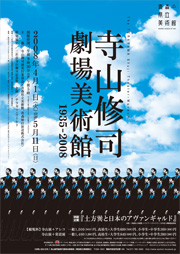The TERAYAMA SHUJI Theatre - Museum :1935-2008
Terayama Shuji(1935-1983) was born in Hirosaki City, Aomori Prefecture.
Terayama was inspired to be a multi-talented artist when he started learning traditional Japanese “Haiku” poems in his high school days.
He is also interested in “Tanka” poems at Waseda University.
Since then, in a stunningly fast speed, he ran through the multimedia world in such areas as radio, TV, movie, and sports writing with a focus on horse racing.
In 1967, Terayama launched an avant-garde theatrical company called “Tenjo-Sajiki Theatre Laboratory” which means “a low priced balcony area”.
The play was performed in an extremely unconventional way.
Through the company, he found his additional talents in the world of fine art, design, and music, and he broadened those talents and delved them into something creative, however he didn’t forget to train many his pupils.
At present, although it is not unusual to hear the phrase “multi-talented”, there really is no other “multi-talented artist” like Terayama.
That’s one reason why he is called a pioneer of multi-talented artists, and still remains in the hearts of the many of the younger generation even today.
Aomori Museum of Art
| Address | 185 Chikano, Yasuta, Aomori, Aomori, 038-0021, Japan |
|
| TEL | 017-783-3000 | |
| bijutsukan@pref.aomori.lg.jp | ||
| Access | (JR) 20 minutes by car from JR Aomori Station (Aomori Municipal bus.) 20 min. by bus bound for “MENKYO-CENTER via Art Museum” from JR Aomori Station.The Bus Stop “Kenritsu-bijutsukan-mae” (Airport) 20 minutes by car from the Aomori Airport. (Highway) 5 minutes by car from the Tohoku Expressway Aomori Interchange
|
Details
Period
40days / April 1 (Tuesday) through May 11 (Sunday), 2008
Close
April 14 (Monday), 2008
Admission
Adults / 1,000 (900) yen
High School & College & University / 600 (500) yen
Schoolchildren & Junior High School / 300 (200) yen
Organizers
The Executive Committee for the Terayama Shuji Exhibition
(Aomori Museum of Art , Asahi Broadcasting Aomori)
Exhibition Structure
In our temporary exhibition, we tried to express Terayama’s condensed creative world consisting of literature, drama, movie, fine art, music, sports, and so on.
We organized these genres into some categories, and showcased plenty of Terayama’s art work and documents in five huge exhibition rooms.
In tribute to the 25th anniversary of Terayama’s death , we are featuring the stage settings, costumes and other items used in one of his famous theater plays, “La Marie-Vision”, which played in 1967.
It is also famously known that this play was written for the actor Akihiro Miwa who had an understanding of Terayama’s arts.
This exhibition is the largest ever for Terayama.
Through this exhibition, we hope you’ll reach deep inside his thoughts and be able to see exactly who Terayama is and what his art means.
In a group of exhibition rooms called “Community Gallery”, in order to guide you to the nostalgic days of Showa era, we are exhibiting the works by many other famous literary men and theatrical producers who are from the same generation as Terayama.
Through the whole exhibition, we’re sure you will be able to touch upon the intelligence of Terayama, which he needed to survive in a chaotic world, understand the words and ideologies he left.
Co-exhibition: HIJIKATA TATSUMI and other Avant-garde artists of Japan
Exhibit at Community Galleries A-C at Aomori Museum of Art
While spotlighting on Terayama Shuji, we also co-exhibit the works by another avant-garde “Butoh” dancer, Hijikata Tatsumi, who was from the Akita prefecture.
He also had a huge impact on the world of traditional theater play during the middle to late Showa era, and a time when many other young and spirited artists were born.
We are also exhibiting the works by other famous literary men and theatrical producers such as Shibusawa Tatsuhiko, Tanemura Suehiro, and Kara Juro.
They had a strong tie with Hijikata.
Through their art works, we were able to study how big of an impact they had on the contemporary art of Japan.
We will be pleased if you are able to enjoy the strong energy of the nostalgic days through this exhibition.


